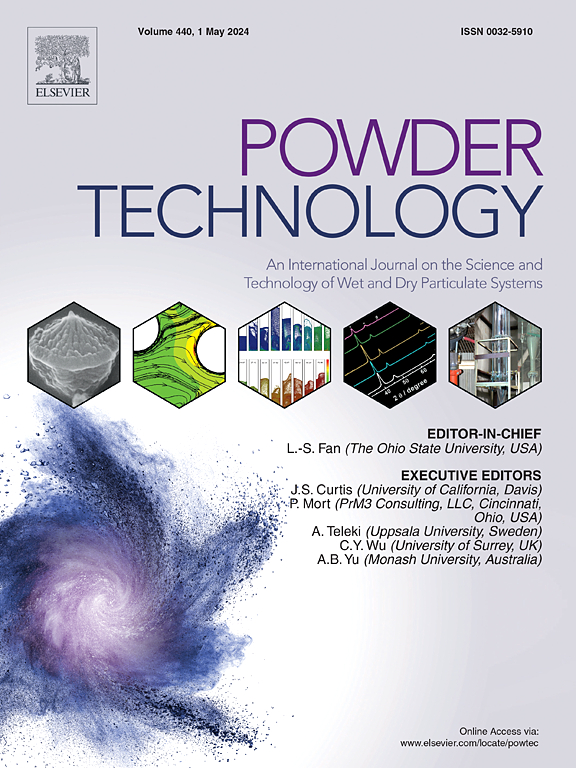Deep oxidation and rupture processes in the aging of boron particles by time-sequenced slicing approach
IF 4.5
2区 工程技术
Q2 ENGINEERING, CHEMICAL
引用次数: 0
Abstract
The energy performance of boron-based energetic materials gradually deteriorates over time, primarily influenced by the formation and evolution of the oxide layer on boron particle surfaces. However, accurately characterizing the structural evolution of this oxide layer remains challenging due to its nanoscale characteristics and inward growth, thereby limiting a comprehensive understanding of the aging process. To address this, this study integrates accelerated aging experiments with micro-nanostructure processing techniques and develops a time-sequenced slicing approach for systematically analyzing the oxidation evolution of boron particles. Experimental results indicate that the growth of the boron oxide layer follows a two-stage process: an early slow-growth phase dominated by boron‑oxygen diffusion, followed by a mid-stage accelerated growth phase driven by structural degradation. The growth rate constants of these two modes differ by approximately a factor of 17.7. During oxidation, the chemical composition of boron undergoes a transformation from elemental boron to mixed boron oxides and eventually to boric acid (B → BnOm → H₃BO₃), leading to a decrease in surface density, an enhancement of oxidation-induced expansion, and the formation of cracks and voids. These structural changes directly influence oxidation kinetics and account for the variation in oxidation rates between the early and mid-aging stages. This study elucidates the microscopic structural evolution mechanism of boron particles under storage conditions, providing critical theoretical insights for optimizing energy performance assessment and storage stability.

时间序列切片法研究硼颗粒老化过程中的深度氧化和断裂过程
硼基含能材料的能量性能随着时间的推移逐渐恶化,主要受硼颗粒表面氧化层的形成和演化的影响。然而,由于其纳米级特性和向内生长,准确表征氧化层的结构演变仍然具有挑战性,从而限制了对老化过程的全面理解。为了解决这一问题,本研究将加速老化实验与微纳米结构加工技术相结合,并开发了一种时间序列切片方法来系统地分析硼颗粒的氧化演变。实验结果表明,氧化硼层的生长过程分为两个阶段:早期以硼氧扩散为主的缓慢生长阶段和中期由结构降解驱动的加速生长阶段。这两种模式的生长速率常数相差约17.7倍。在氧化过程中,硼的化学成分经历了从单质硼到混合硼氧化物的转变,并最终变成硼酸(B→BnOm→H₃BO₃),导致表面密度降低,氧化引起的膨胀增强,并形成裂缝和空隙。这些结构变化直接影响氧化动力学,并解释了早期和中期老化阶段氧化速率的变化。该研究阐明了硼颗粒在储存条件下的微观结构演化机制,为优化能量性能评估和储存稳定性提供了重要的理论见解。
本文章由计算机程序翻译,如有差异,请以英文原文为准。
求助全文
约1分钟内获得全文
求助全文
来源期刊

Powder Technology
工程技术-工程:化工
CiteScore
9.90
自引率
15.40%
发文量
1047
审稿时长
46 days
期刊介绍:
Powder Technology is an International Journal on the Science and Technology of Wet and Dry Particulate Systems. Powder Technology publishes papers on all aspects of the formation of particles and their characterisation and on the study of systems containing particulate solids. No limitation is imposed on the size of the particles, which may range from nanometre scale, as in pigments or aerosols, to that of mined or quarried materials. The following list of topics is not intended to be comprehensive, but rather to indicate typical subjects which fall within the scope of the journal's interests:
Formation and synthesis of particles by precipitation and other methods.
Modification of particles by agglomeration, coating, comminution and attrition.
Characterisation of the size, shape, surface area, pore structure and strength of particles and agglomerates (including the origins and effects of inter particle forces).
Packing, failure, flow and permeability of assemblies of particles.
Particle-particle interactions and suspension rheology.
Handling and processing operations such as slurry flow, fluidization, pneumatic conveying.
Interactions between particles and their environment, including delivery of particulate products to the body.
Applications of particle technology in production of pharmaceuticals, chemicals, foods, pigments, structural, and functional materials and in environmental and energy related matters.
For materials-oriented contributions we are looking for articles revealing the effect of particle/powder characteristics (size, morphology and composition, in that order) on material performance or functionality and, ideally, comparison to any industrial standard.
 求助内容:
求助内容: 应助结果提醒方式:
应助结果提醒方式:


